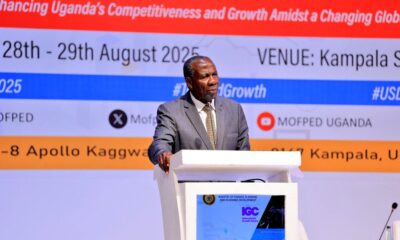Columnists
Uganda’s future is in industry – and here is how we can achieve it
Uganda is currently grappling with a historic paradox – growth without transformation. Uganda is known for some robust GDP growth, particularly in the period 1990 – 2010, although in recent years this growth has become sporadic
Much of current government policy is targeting to recovery. However, we shouldn’t forget that even when the economy was growing rapidly, the growth profile remained jobless and barely sustained. Over three quarters of Ugandans remained stuck in low productivity subsistence agriculture.
The few Ugandans who escaped subsistence and joined commercial farming, industry and formal services prospered. This led to rising inequality to the extent that the richest 20% of Ugandans shared half of the national income, while their poorest contemporaries shared only 6%.
Since Uganda’s growth has been happening in low productivity sectors, particularly informal services, it did not create jobs. We heard from authorities how growth was robust as joblessness, particularly among educated young Ugandans, increased to the point where one job had 500 qualified applicants. Did we learn any lessons?
Why not services?
Economists teach us that transformation occurs when production and employment shift from agriculture and other primary sectors (such as mining) to manufacturing and finally to services – in that order.
Empirical researchers have always told us that “all countries that transformed their economies have done so by industrialising.” We seem to have jumped from agriculture to services. Yet, services have never acted as an escalator sector. Why?
First, services such as information technology require high skills – long years of education and institution building are required before farm workers can be transformed into programmers or call center operators.
Second, services are less tradable (less exportable), with some exceptions such as cell phones and tourism. Uganda’s growth is driven mainly by non-tradable activities (things we do not export): construction and real estate, public sector investment, mobile telephony, transport, banking, and education and health services.
Stagnant manufacturing sector
If you engage in non-exportable activities your capacity to create jobs is limited since you are relying on the low domestic demand, itself vulnerable to internal political business cycles and other shocks – macroeconomic shocks, weather, demographic changes etc.
Although it would be wrong to think that the past will necessarily look like the future, I wouldn’t want to think that Uganda, or Africa in general, will be the first to reinvent the wheel. If we want to transform our economy we are going to do so by investing in manufacturing.
It has stagnated at about 7% of GDP for the past 40 years. Its share in total employment has also stagnated at 5.7%. It has been left to SMEs that make up over 93% of firms operating in the manufacturing sector.
Empirical research shows that industrial upgrading has never happened through market forces. The market gave all industrialised countries unambiguous signals that they should not promote the industries they dominate today.
Carrots and sticks
When Toyota’s attempt to export its first passenger cars to the US in 1958 flopped, many Japanese economists argued that the country should stop subsidising the ‘wrong industry’ – car manufacturing – and stick to silk.
Imagine what the world would be today had the Japanese government listened to those economists! Imagine a world without Toyota. The same can be said of Samsung and Hyundai (South Korea), Nokia (Finland) and many others.
Turning to Uganda, manufacturing sector faces a number of constraints but research shows most of them are symptoms of the following diseases:
First, the generic policy framework, without practical coordination and linkages among government ministries, departments and agencies (MDAs) involved in Uganda’s industrialisation agenda.
Uganda’s MDAs are more obsessed with mandates and budgets (the means) instead of focusing on the end. To solve this, government must restructure itself. Currently, coordinating authorities such as the Office of Prime Minister and Ministries are ineffective and powerless.
They should be empowered to use both carrots and sticks for different behaviours. Our government must learn to sack people who fail to deliver, and reward performers. Agencies that fail to perform should be closed instead of creating parallel ones to circumvent the non-performing ones.
Capitalize UDC
Most importantly, leaders must understand that policy documents alone will not industrialise Uganda. We shall need to act and learn from the mistakes and failures.
For example, now that governance at the revived Uganda Development Corporation (UDC) has been strengthened with a new board and a new strategic and investment plan; let government capitalise its investment arm.
The economic ideological dogma that used to worship markets and private sector-led models as if they were magical wands has been globally disproved.
Any well-meaning person now agrees that the state, despite its shortcomings (popularly referred to as government failures) has a role to play particularly when it comes to experimenting industries where private sector is disinclined.
The past three decades must also have taught us that a number of market failures impeded industrialisation. Information externalities, for examples, are everywhere for us to notice. Markets are sending wrong signals to entrepreneurs—invest here, not there; yet they should have invested there, and not here.
Minimise ‘learning costs’
To solve this, government must minimise “learning costs” for private sector. The learning process for manufacturing is too long and often involves huge financial losses. That is why private sector has avoided manufacturing (both as an investment and financing area).
Let us use UDC to experiment industries with uncompetitive cost structures. Once the private sector is assured of a return on investment, it will not wait for invitation or ‘facilitation’.
Since in today’s globalised world it is no longer practical to use conventional industrial policy instruments – such as tariffs, exchange controls, and import licensing – to nurture infant industries, we should use UDC to incubate these industries with a view of passing the mature industries on to private sector.
In principle, although private firms, not state-owned enterprises, must be the engine of industrial production and management, the state should directly invest in the experimentation stage of industries – iron and steel, petroleum, agro-manufacturing, and other export-oriented manufactures.
Another reason we need the state to invest directly in manufacturing is because, research shows, decision making in industry should not be based on cost-benefit analysis. Why? Industries take long to mature into profit-making entities.
Some of them actually never mature into profit-making entities, but serve other developmental functions particularly keeping per capita incomes and employment growing.
Reform tax regime
To accelerate industrialisation, government will need to do a few things: first, it should directly provide low interest loans (not handouts) to industrialists, particularly those investing in manufacturing. The song of capitalizing Uganda Development Bank (UDB) without walking the talk should stop.
The hundreds of billions being squandered in handouts and piecemeal interventions across MDAs should be consolidated and put in UDB and UDC.
Secondly, we should reform tax regime such that indigenous industrialists have advantage over importers. Currently, import trade is more profitable than manufacturing. Every year the President laments about Uganda’s huge import bill but his government is not doing anything practical to stop it.
We need to establish why Ugandans with investable capital are into import trade and construction of non-tradables such as shopping malls, apartments and speculating on land. The tax regime is one tool we may use to turn the odds against these activities and in favour of manufacturing, tourism and commercial agriculture.
Thirdly, we need to condition state incentives for private sector to productivity and export discipline, using both carrots and sticks for different behaviours. After a reasonable period, the state should withdraw support from firms that cite small domestic market as an impediment for their growth.
Learn by doing
In all countries where industrial policy succeeded, the state forced private firms to export. This forces firms to be competitiveness in international markets as a metric for determining those that deserve state help.
Third, and related to the second, there is need for clear guidelines or criteria for accessing exemption schemes, duty-drawbacks, and export-processing zones for manufacturers. This will help to screen out rent-seekers and thus reduce adverse-selection problem (attracting ‘bad’/fake investors).
Fourth, there is need to expedite the enactment of competition law and other anti-trust laws to enforce competition. We shall not build this economy, let alone industry, when we let cartels to roam freely.
Prices of fuel, inputs such as cement, bank money and utilities will always be a problem for investors as long as there is no law that compels them to compete, instead of colluding.
Lastly, let us learn to implement projects. Everywhere they learn by doing. They also improve by punishing conscious poor performance and rewarding good performance. In Uganda, we have built a culture that people can not only get away with avoidable mistakes, but get rewarded for adding no value. Which incentive mechanism is this?
Comments






















